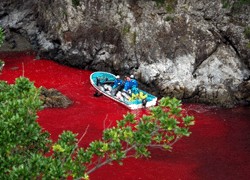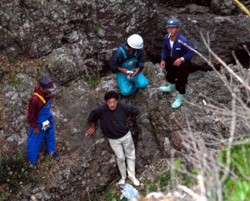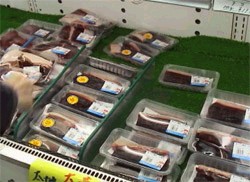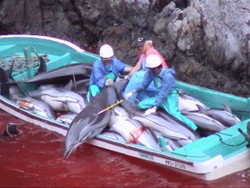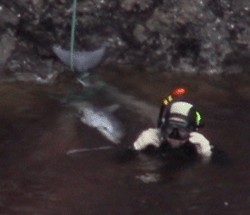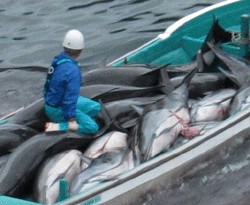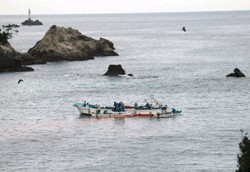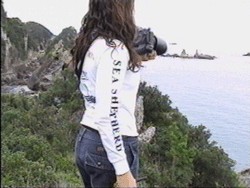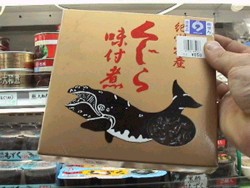|
Activists film bloody dolphin kill in Japan
Posted 31st October 2003
Compiled from an article on
29th October 2003 at
Independent on Line
www.iol.co.za
Pictures and Video Clip
Courtesy & ©
Sea Shepherd
Our thanks to Local-2 Ltd for hosting the Taiji dolphin slaughter .mpg file
Taiji, Japan - An American anti-whaling group trying to stop the killing of dolphins has released video footage of a recent hunt in the small fishing town of Taiji that shows blood-filled coves and several dead dolphins being brought ashore in boats.
The tape, shot by the Sea Shepherd Conservation Society, graphically captures the end of a hunt, in which fishermen pound on the water, causing waves that confuse the mammals' sense of direction, and then corral dolphins into small coves where they can be more easily killed.
Though subject to government-set quotas, the hunts are not banned under Japanese law and are not subject to international regulations because they are done near the shore.
Several dead or dying dolphins can be seen on the boats, bleeding profusely, in the footage.
The meat is usually canned and sold in supermarkets
"It's a wholesale slaughter, which results in immense suffering for these animals," said activist Nik Hensey. "It's a sight that one just can't imagine."
Requests for comment from the mayor were denied and other town officials declined to comment. A fisherman's union representative, who demanded anonymity, said the kills are conducted as humanely as possible, and noted that dolphin hunts have been part of local culture for 400 years.
Hunting dolphins is not banned by the International Whaling Commission, which has maintained a moratorium on commercial whaling since 1986.
Fishermen in this western Japanese town regularly conduct dolphin hunts during the October to April season. They've caught more than 60 striped dolphins so far this year under the government quota system. The meat is usually canned and sold in supermarkets.
But because of international pressure for an end to the killing of dolphins and the bloodiness of their hunting method, fishermen here have tried to keep out of the public eye. They do not permit videos of their hunts, refuse on-the-record interviews and have even erected barriers along the shoreline to discourage cameramen.
Japan is also allowed to kill hundreds of whales a year
The Sea Shepherd activists said they managed to get the video by camping out in town for several weeks. They provided Associated Press Television News with a copy of their footage.
Three activists from the Malibu, California-based conservation group were briefly detained by Japanese police after allegedly trying to stop a dolphin hunt and scuffling with a fisherman earlier this month.
The activists - a Briton, a Canadian and an American, all in their 20s - were taken in for about nine hours of questioning before being released. They weren't charged with any crimes.
Japan is one of the few major fishing nations that continues to support the hunting of whales and dolphins.
Officials here say the populations of many of the marine mammals have recovered enough to sustain limited catches, and have argued that pressure to quit killing them is based more on cultural biases than on science.
Under a special IWC allowance, Japan is also allowed to kill hundreds of whales a year. Critics say the catch is commercial whaling in disguise because most of the meat ends up being sold in markets and restaurants.
Tokyo counters that the kills are done as part of a research programme needed to study whale populations and migration patterns
Click on either of the Icons shown below to download a video player
Top
|

